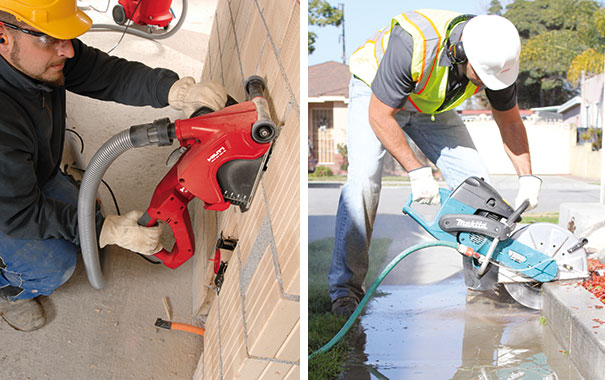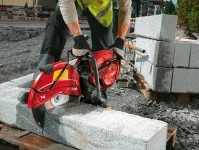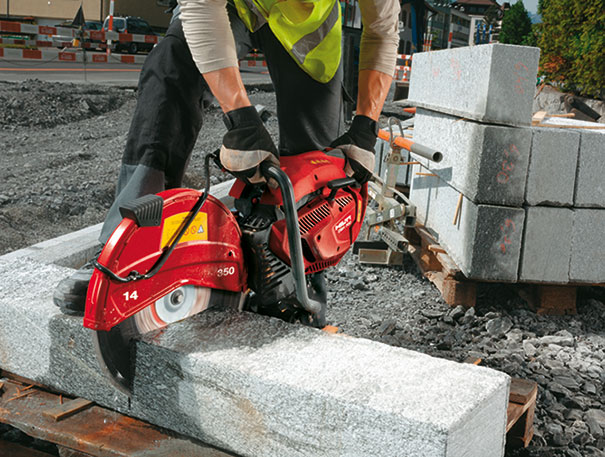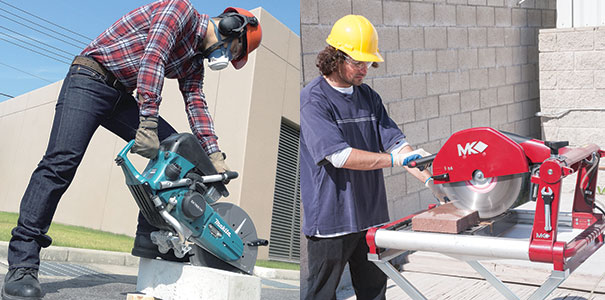Saws
By Jennifer Morrell
 Masonry wanted a hard-nosed look at what makes the saw industry tick, so we went to three experts to get the real scoop on what has changed – and what hasn’t – in the masonry saws industry.
Masonry wanted a hard-nosed look at what makes the saw industry tick, so we went to three experts to get the real scoop on what has changed – and what hasn’t – in the masonry saws industry.
David Fernandez is product manager, commercial products, for Makita U.S.A. Inc. Saw industry veteran Brian Delahaut, VP of MK Diamond Products Inc., has worked for the company for more than 30 years. And David Walker, business unit manager, cutting and grinding for Hilti. Each provides valuable feedback regarding how and why saws have changed, and what mason contractors need to know and consider when it comes to saws for their jobsites.
Masonry: Flash back to 25 years ago; how far have saws come in weight and ergonomics/comfort?
Walker, Hilti: Gas saws have had changes, some of which are driven by EPA guidelines. Newer saws have better gas consumption, cleaner running, less smoking, and much better power-to-weight ratio. Most saws are now fitted with water systems to reduce dust and some noise. Some saws (Hilti) now have wheels for better operator comfort. Some manufacturers offer small floor carts to help with straight cutting and operator ease for long cuts. Other changes include easy-to-repair maintenance items like pull cords and air filters, so that repairs can be done at the jobsite. This, along with better filter cleaning with some of the new turbo-style filter systems, means almost no daily maintenance.
Fernandez, Makita: Users have benefitted greatly from Makita innovation with improved ergonomics, increased comfort, less weight, and the convenience of faster starts. At the end of 2013, Makita launched the EK7651H 4-Stroke Power Cutter. The EK7651H offers improved ergonomics with a recessed aluminum wheel kit that helps reduce fatigue during long, straight cuts. The Makita MM4 4-stroke engine has measurably lower emissions and noise than traditional two-stroke engines for greater user comfort, cut after cut.
Hard-starting power cutters cause unnecessary fatigue, frustration and delay, and Makita power cutters are engineered for faster, easier starts, with features like automatic decompression on the EK7651H and EK6101. On the EK7651H, the decompression valve is engineered into the cam gear to reduce the pull start force by up to 40 percent and is automatically engaged with each pull. In addition, a pressure-compensated carburetor with vented choke plate allows for optimum fuel delivery, and reduces the occurrence of flooding during cold starts. For users who need less weight, Makita offers the 14-inch EK6101. At just 19.3 pounds, it has the lowest weight in the 14-inch power cutter category.
Masonry: Should all saws have an automatic cut off? What role do OSHA rules and regulations play in the design and planning of a new or updated saw?
Walker, Hilti: This is a similar question to angle grinders, which have dead-man switches or a constant-on switch. A lot of it depends on the application and customer need. OSHA and other national standard requirements are incorporated in the design of all Hilti saws. With new requirements for slurry containment, dust and noise reduction/collection, this will influence modern tool design as customers begin to ask for more of these features.
Masonry: Are saws getting smaller and more compact, or are sizes remaining about the same?
Walker, Hilti: There are two gas saw markets in the United States – less-than-70-cc and greater-than-70-cc motors. The smaller engine saws are lighter and more compact, while the greater-than-70-cc motor saws are a few pounds heavier but offer more power. There is a tradeoff between weight and power.
Electric saws are also making a strong showing for indoor applications as well as some of the lighter outdoor applications, due to less mess, no gas fumes, and virtually no maintenance.
Fernandez, Makita: Usually, there is a tradeoff between power and weight in power cutters. Typically, low weight results in lower power, and increased weight results in higher power. Makita power cutters deliver industrial performance and results, yet are more compact with less weight and superior ergonomics for increased user comfort. Makita continues to innovate with 14-inch power cutters that offer superior power-to-weight ratios. The 14-inch EK7301 delivers a full 5.1 horsepower, with a powerful 73-cc engine, yet weighs only 22 pounds; and the 14-inch EK6101 weighs only 19.3 pounds, the lowest weight in the 14-inch category.
Masonry: Are battery-powered saws heavier or lighter? What about gas-powered saws?
Walker, Hilti: Battery-powered saws tend to be lighter and smaller. Some of that depends on the size of the battery. The battery saws entering the market are generally intended for indoor and shorter duration, lighter applications with shallow cuts needed. Battery life, power, performance and depth of cut are all limiting factors currently for battery-powered masonry saws. Future battery technology could improve these saws. For gas saws, it’s all about power versus weight – the more power, the heavier. Lighter, smaller and more efficient saws will continue to be important to the market.
Masonry: Any other comments about the ergonomics and safety of today’s saws for mason contractors?
Walker, Hilti: Saws are becoming more ergonomically designed with better handles, better dust control, wheels, safety devices such as GFCIs (electric saws), blade stops, and better and easier-to-adjust guards. The future is about productivity, safety and environmentally friendly products.
Fernandez, Makita: Makita has a power cutter for every user need. For superior power-to-weight ratio, the EK7301 delivers power for demanding applications, yet weighs only 22 pounds. For the lowest weight in the category, the EK6101 weighs only 19.3 pounds with little loss in power for users making overhead or repeated cuts. For users who require added cutting capacity, the 16-inch EK8100 has a maximum cutting depth of 5 ¾ inches, yet weighs only 23.3 pounds.
And, for users who require a full range of performance features and convenience, the Makita MM4 4-stroke engine EK7651H combines the economy of four-stroke and convenience of no fuel mixing with comfort features, like lower noise and vibration, faster and easier starts, and a retractable aluminum wheel kit for improved ergonomics on long straight cuts.
Delahaut, MK Diamond: Today’s masonry saws are built with many safety features, which incorporate safety and ergonomics into the operational functions of the saws. However, it is most important for the operators to read and understand how the equipment they are operating is intended to be used. The operating manuals of today’s saws are very comprehensive and cover numerous topics, from saw set up to operation, maintenance to trouble shooting and various methods for cutting. The best safety methods for contractors to deploy are to know and understand how the saw operates and what features have been built into the saw for their use.
Safety for masonry saws involves every level of the organization, instilling a safety culture that ensures that every operator is familiar with the equipment they are using. This further reduces accidents for workers and improves the bottom line for managers.


